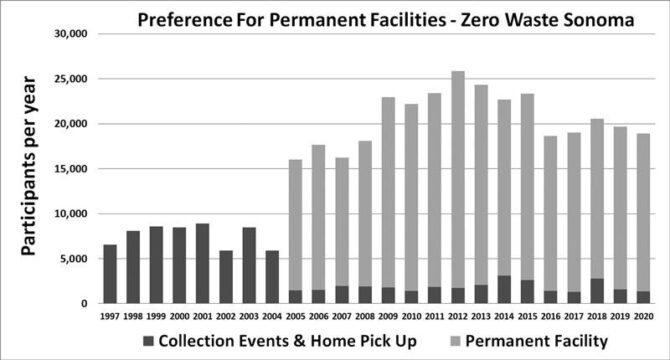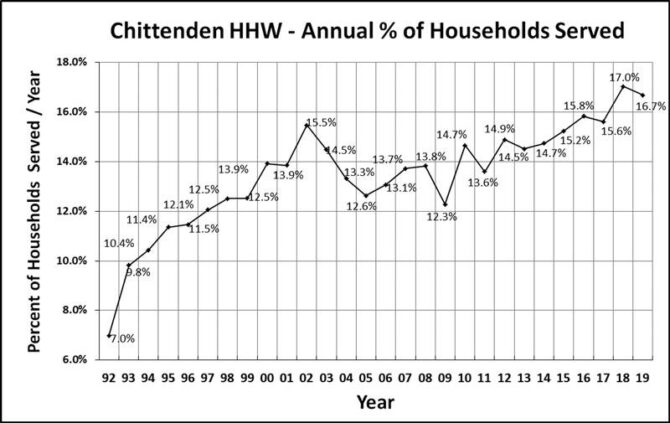This month we will look at two HHW collection programs in the U.S.—the Chittenden Solid Waste District in Vermont, and the Zero Waste Sonoma HHW program in California. We will examine some of the key operating parameters of each program and their results, including HHW collection effectiveness.
Service Areas, Demographics and Convenience
Zero Waste Sonoma serves the Sonoma County population of about a half-million people over a service territory of more than 1,500 square miles. This yields a county population density of about 333 persons per square mile. The county stretches from the north edge of the San Francisco Bay northwest to the Pacific Ocean above Marin County.
Santa Rosa, the largest city, is near the center of the county. Many smaller cities and towns are dispersed, more urban to the south and becoming very rural as you head to the northern extents. The permanent HHW collection facility is located at a transfer station in a rural area to the south of Santa Rosa, but miles from the main Highway 101 where many commute to work in San Francisco or other places south. So, unless a household is already destined to visit the transfer station, going to the HHW facility is a special trip, less than ideal convenience for most residents.
Chittenden Solid Waste District serves all of Chittenden County with about 164 thousand people over 619 square miles in northwest Vermont. This yields a county population density of about 265 persons per square mile. The population center is at Burlington on Lake Champlain across from New York and not far from the Canadian border.
The county spreads out from the Burlington area to smaller cities and rural towns north, east and south. Burlington is the economic and residential center of the county and the only large city in the region. Consequently, Chittenden’s South Burlington HHW facility location is convenient for a large part of the county.

Figure 1: Customer preference for year-round permanent facility. Images courtesy of Special Waste Associates.

Figure 2: Chittenden SWD HHW participation rates.
Zero Waste Sonoma HHW Collection Operations
Zero Waste Sonoma relies on competitive contracts for all operations of their HHW collection system. There is one permanent HHW collection facility, which is co-located with a landfill, transfer station and recycling center. Zero Waste Sonoma also offers weekly collection events at selected locations throughout the county. Zero Waste Sonoma serves a small number of residents who are elderly or otherwise home-bound with appointment-based at-home pick up service. This at-home pick up service is available to other households for a $50 service fee per pick up, but is lightly used.
The cost per HHW customer served is $84.34, which is in the average range of HHW program costs. Expenses include waste contractors, administrative, contract management and overhead costs. Unlike many HHW programs, electronic waste (e-waste) management is completely separate from the HHW program. If e-waste customers were included in the HHW count for the Zero Waste Sonoma program, as it often included at other jurisdictions, the number of participants would be greater and percentages of households served per year would be significantly higher.
Until building their permanent collection facility, for many years Zero Waste Sonoma offered HHW collection only through their collection events and pick up service. Therefore, we can compare customer preference for collection methods before and after establishing the permanent collection facility. Figure 1 shows that the public much prefers to deliver their HHW to a permanent collection facility instead of coordinating the HHW delivery timing during a collection event in their community. In addition, Figure 1 shows that by providing a permanent facility collection option, the annual participation rate immediately jumped to a higher level and remains higher from that point forward. This jump in participation is typical when programs establish a permanent collection facility and no longer rely solely on collection events or stop offering collection events entirely.
Zero Waste Sonoma Collection Performance Metrics
In 2019, the Zero Waste Sonoma HHW collection system served 9.6 percent of households. We can use that statistic to calculate the HHWEff% , collection performance metric, as discussed in November’s HHW Corner article.
Using that formula, the county-wide HHW collection effectiveness is a very respectable 71%:
At a nearly 10 percent participation rate, or 71 percent HHW collection effectiveness, the Zero Waste Sonoma HHW collection program is a top tier performer. As mentioned previously, and unlike many other HHW collection programs, the 9.6 percent participation rate excludes households participating only in the e-waste collection program.
Recent detailed analyses performed for Zero Waste Sonoma shows that the level of HHW collection service varies significantly between different locations in the county. Generally, and not surprisingly, the participation rate is related to the distance to the permanent collection facility. HHW collection is more effective for communities located closer to the permanent HHW collection facility.
Consequently, the county is considering establishing another collection facility to better serve the households in the northern areas of the county. If a north Zero Waste Sonoma HHW collection facility is established, I would anticipate that the HHWEff.% metric would increase to a higher level, reflecting the increased convenience of HHW collection services.
Chittenden Solid Waste District HHW Collection Operations
Chittenden Solid Waste District staff operate all the HHW collection activities, which includes their permanent collection facility in South Burlington, as well as a mobile collection event program that parallels the Zero Waste Sonoma HHW collection events program. The Chittenden permanent HHW collection facility, called the Environmental Depot, was a pioneering effort begun in the early 1990s.
Looking only at expenses in fiscal year 2019, the Chittenden Solid Waste District HHW program’s cost per participant was about $63.
Revenue sources in 2019, which offset these costs, included:
The resulting net cost per participant for the Chittenden HHW collection program was reduced to about $38. This demonstrates how a combination of locally-generated revenue, state financial assistance and EPR programs can provide a large financial benefit to local HHW programs.
Chittenden HHW Collection Performance Metrics
Figure 2 shows how the level of participation quickly increased to high levels and has continued to trend upwards over the past few decades. Like at Zero Waste Sonoma, the vast majority of participants use the permanent collection facility instead of their mobile collection events.
The level of annual participation at Chittenden SWD has consistently made them one of the most effective HHW collection programs in the U.S. The very convenient location of the facility in South Burlington, which is the focal point of population and economic activity in the area, along with the presence of University of Vermont, has likely contributed to the success of the Chittenden HHW collection program. The most recent full-year of data shows an exceptional participation rate of 16.7 percent, which translates to an HHWEff.% = 124%.
One of the most notable efforts of the Chittenden HHW program is their focus on paint recycling. Chittenden took their lead from Portland Metro, OR, who has long been a pioneer in recycling their own as well as neighboring jurisdiction’s latex paints.
The Chittenden approach includes not only recycling their own latex paint, but also partnering with paint recyclers in Canada and branding their own recycled paint with artwork donated by a local artist. Their “100% Premium Re-Blended Latex Paint” is called “Local Color”. The Local Color label is shown in Figure 3 with the tag line “Collected From Vermonters For Vermonters”.
Wrap-up
Zero Waste Sonoma and Chittenden Solid Waste District show what can be accomplished over time with persistence and local support of HHW collection programs in different climates and demographics. Whether implementing a program exclusively through contractors like Zero Waste Sonoma, or operating an HHW program with hired staff, as chosen by Chittenden Solid Waste District, high levels of HHW collection effectiveness is achievable. As with recycling and other waste collection services, convenience matters. Establishing a permanent HHW collection facility helps achieve high levels of HHW collection program effectiveness beyond what is possible with collection events. Having a conveniently-located facility drives program effectiveness even higher. Finding creative revenue sources and leveraging EPR programs can significantly assist in keeping local program costs affordable. | WA
David Nightingale, CHMM, S.C., is Principal at Special Waste Associates (Olympia, WA), a company that assists communities in developing or improving HHW and VSQG collection infrastructure and operations. They have visited more than 145 operating HHW collection facilities in North America. As a specialty consulting firm, Special Waste Associates works directly for program sponsors providing independent design review for new facilities or upgrading existing facilities—from concept through final design for safer, more efficient and cost-effective collection infrastructures. Special Waste Associates also published the book, HHW Collection Facility Design Guide.
Thanks to Courtney Scott from Zero Waste Sonoma and Josh Estey from Chittenden Solid Waste District for their assistance in making this article possible.
Household hazardous waste (HHW) demands special attention because it represents the most toxic fraction of the municipal solid waste stream. Proper HHW management encompasses a special set of safety, training, design, and policy issues that are separate and apart from other solid waste programs. HHW Corner delves into these unique issues. If you have a question about this article or suggestions for HHW Corner topics that you may like to see covered in future editions of Waste Advantage Magazine, contact David at (360) 491-2190 or e-mail contact@specialwasteassoc.com.